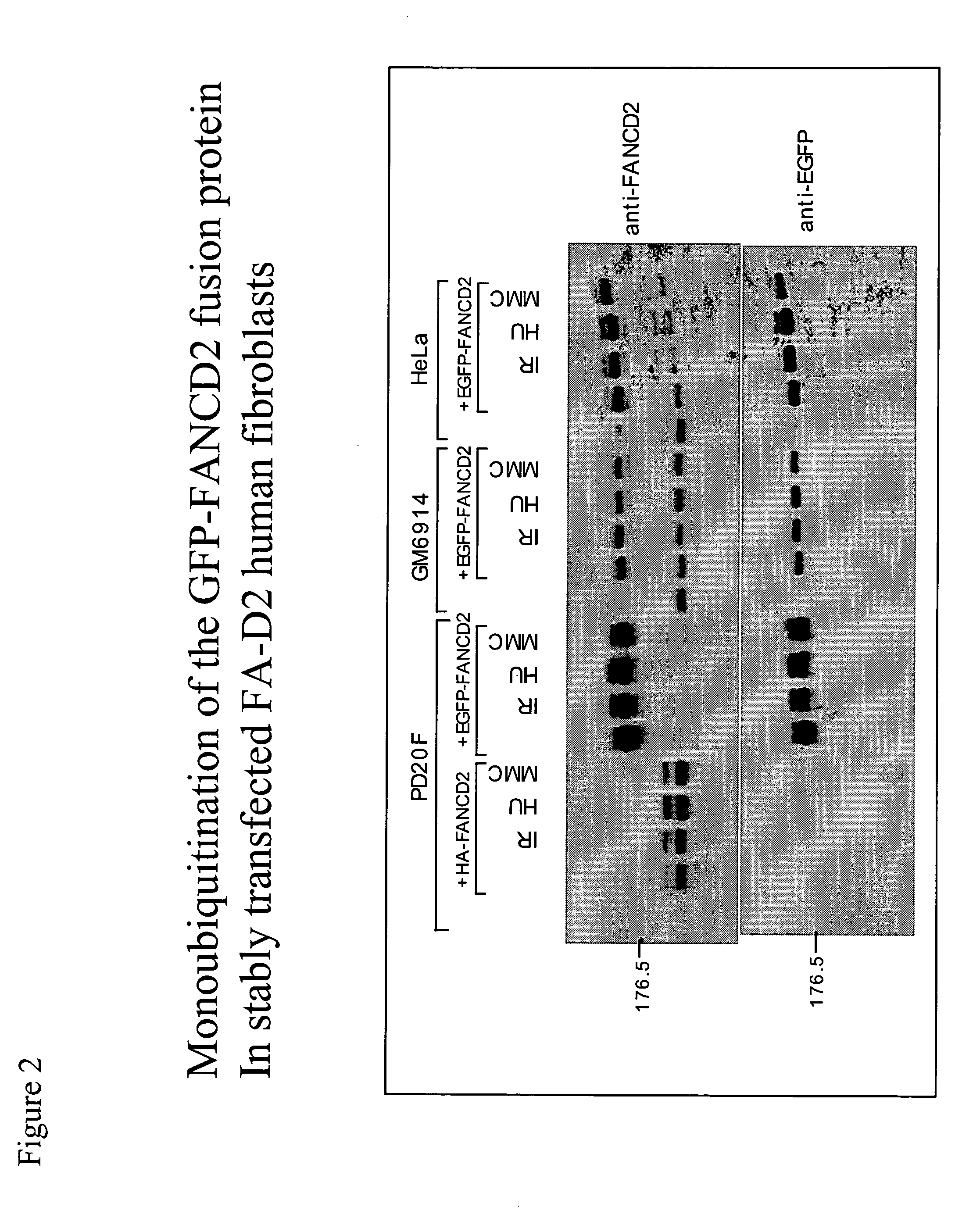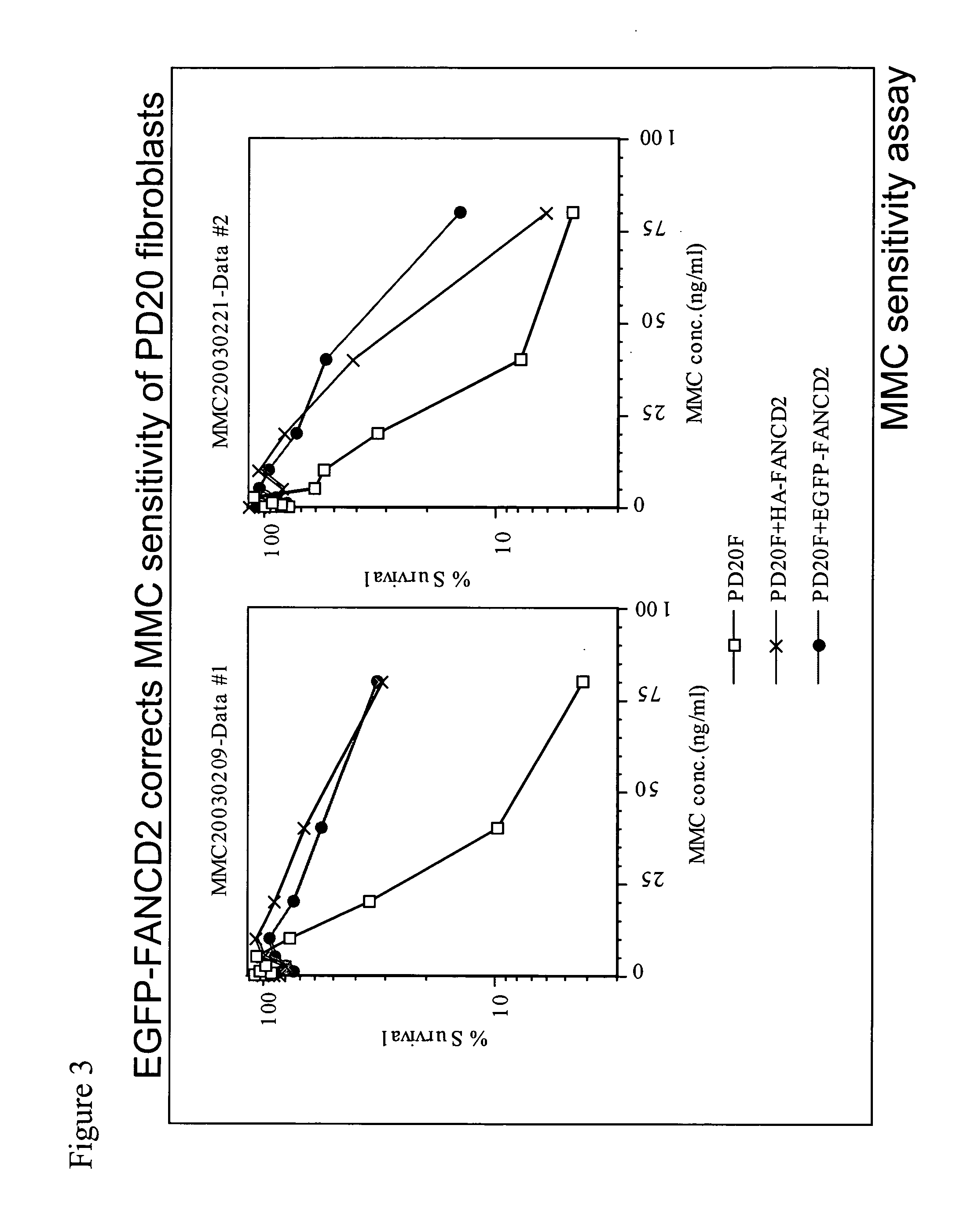Method for determination and quantification of radiation or genotoxin exposure
a genotoxin and radiation field technology, applied in the field of radiation or genotoxin quantification methods, can solve the problems of chromosome instability, genotoxic stress, and exposure of individuals to hazardous levels of genotoxic agents, and achieve the effect of enhancing the formation of fancd2-containing foci
- Summary
- Abstract
- Description
- Claims
- Application Information
AI Technical Summary
Benefits of technology
Problems solved by technology
Method used
Image
Examples
example 1
Development of an Antibody that Specifically Recognizes the Monoubiquitinated Isoform of FANCD2
[0173] Antibodies to FANCD2 (monoclonal and polyclonal) were raised against the amino terminal region of FANCD2. These antibodies recognize both isoforms of FANCD2 (FANCD2-S and FANCD2-L). To make an anti-FANCD2-L antibody, we have generated a specific antigen (FIG. 10), containing a region of FANCD2 linked covalently to the carboxyl terminus of ubiquitin (Ub). We injected mice with this antigen, and raised monoclonal antibodies (FIG. 11). These monoclonal antibodies will now be analyzed for their specific diagnostic value, as described above.
example 2
Clinical Protocol for Taking Samples
[0174] Blood is drawn 24 to 48 hours after the alleged exposure, since, based on in vitro data, this is the peak time of foci formation. Again, different antisera, (say for FANCD2, BRCA1, and Histone 2AX) may differ significantly in the actual time of peak foci and in the duration of foci in vivo. Peripheral blood lymphocytes (PBLs) are isolated using a standard ficoll gradient. Cells are then stained with specific antisera to Histone 2AX, BRCA1, and FANCD2, and the percentage of cells with IRIFs and the number of IRIFs per cell are measured. Using a standard curve based on the amount of time which has elapsed since alleged radiation exposure, the likely dose of exposure to genotoxic agents is determined. Based on this dose, genotoxic protective agents are administered if needed.
I. Clinical Protocol
[0175] Oncology patients are enrolled who are receiving radiation or genotoxic chemotherapeutic agents for their tumor (head and neck squamous cell...
example 3
Dose-Dependent Generation of FANCD2 Monoubiquitination
[0176] We have previously shown that DNA damage activates FANCD2 monoubiquitination and that FANCD2 monoubiquitination correlates with FANCD2 nuclear foci formation (Garcia-Higuera et al., Mol Cell 7:249-262, 2001). As shown in FIG. 13, several kinds of genotoxic stresses (MMC, IR, ultraviolet light) can activate FANCD2 monoubiquitination (panel A, B, C) or FANCD2 foci formation (panel D). Interestingly, there was a time-course dependent and dose-dependent activation of FANCD2. In this analysis, FANCD2 foci were observed only 4 hours after IR and were observed after 5 Gy of IR (panel D). More refined studies (FIG. 12), also performed in HeLa cells, indicate a dose-dependent increase in FANCD2 monoubiquitination, even in the 0-5 Gy radiation range (i.e., low radiation exposure), further suggesting that FANCD2 foci formation may be a very sensitive indicator of radiation exposure. Preliminary studies indicate that irradiation of p...
PUM
| Property | Measurement | Unit |
|---|---|---|
| time | aaaaa | aaaaa |
| chemiluminescent | aaaaa | aaaaa |
| fluorescent | aaaaa | aaaaa |
Abstract
Description
Claims
Application Information
 Login to View More
Login to View More - R&D
- Intellectual Property
- Life Sciences
- Materials
- Tech Scout
- Unparalleled Data Quality
- Higher Quality Content
- 60% Fewer Hallucinations
Browse by: Latest US Patents, China's latest patents, Technical Efficacy Thesaurus, Application Domain, Technology Topic, Popular Technical Reports.
© 2025 PatSnap. All rights reserved.Legal|Privacy policy|Modern Slavery Act Transparency Statement|Sitemap|About US| Contact US: help@patsnap.com



